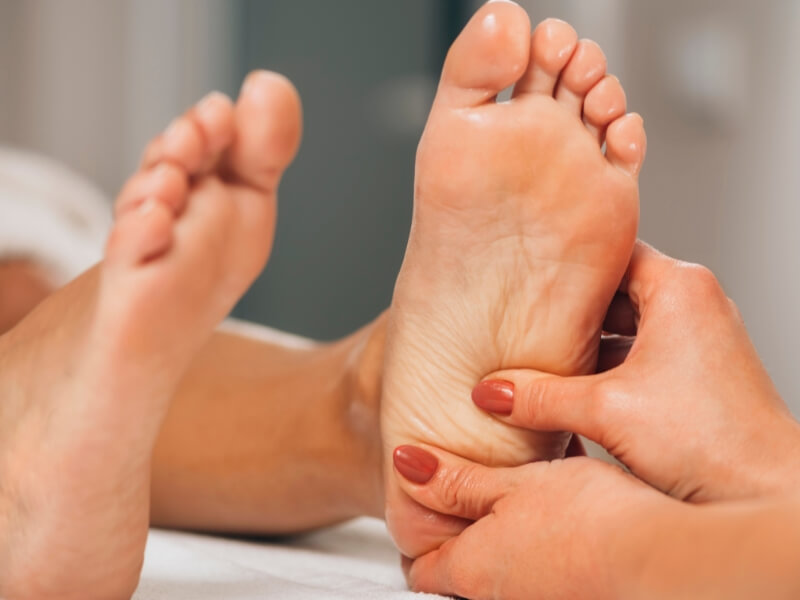Fibromyalgia is a chronic condition that causes widespread pain, fatigue, and a host of other challenging symptoms. It significantly affects the quality of life of those who suffer from it. As the medical community continues to seek effective treatments, many are turning towards complementary therapies like reflexology for relief. Reflexology is a non-invasive therapy that stimulates specific pressure points, mainly on the feet, to promote healing and relaxation throughout the body. The treatment aims to reduce pain and improve overall well-being through a holistic approach. In this article, we explore the potential of reflexology for fibromyalgia as a complementary treatment, examining its benefits, research findings, and considerations for those living with fibromyalgia.
Understanding Fibromyalgia : Causes and Symptoms
In fibromyalgia, pain is widespread and persistent, affecting various parts of the body and significantly impacting daily life. A combination of genetic, environmental, and psychological factors is believed to contribute to the condition, though its exact cause remains unknown.
It’s suggested that the condition is related to abnormal levels of certain chemicals in the brain and changes in how the body processes pain signals. As a result, people with fibromyalgia might feel pain more intensely than those without it, a condition known as abnormal pain perception processing.
Common symptoms associated with fibromyalgia include:
- Widespread pain
- Profound fatigue
- Sleep disturbances
- Cognitive difficulties (“fibro fog”)
- Morning stiffness
- Headaches
- Irritable bowel syndrome (IBS)
- Tingling or numbness in hands and feet
- Sensitivity to pain, light, noise, and temperature
- Anxiety and depression
- Painful menstrual periods
The severity of symptoms can vary from person to person, making it a challenging condition to manage.
Benefits Of Reflexology For Fibromyalgia Patients
Can reflexology help fibromyalgia? Reflexology is a calming and balancing therapy that may assist individuals dealing with fibromyalgia. This holistic therapy that involves applying pressure to precise points to stimulate the body’s natural healing response. These points, known as reflexes, are believed to correspond to different organs, glands, and body systems.
By applying pressure to these reflexes, reflexologists aim to restore balance and promote overall well-being. Reflexology is based on the principle that the body is interconnected, and any imbalance in one area can affect the entire body.
Reflexology can offer numerous benefits for individuals with fibromyalgia, including:
- Pain Relief: Aims to alleviate the constant dull ache by targeting specific pain areas, helping to isolate and gradually reduce pain intensity.
- Improvement in Sleep and Fatigue: Helps alleviate sleep disturbances associated with fibromyalgia.Contributes to better sleep quality and duration, breaking the cycle of fatigue and discomfort.
- Increased Circulation: Enhances blood flow, delivering more oxygen and nutrients to body tissues, which may aid healing and energy levels.
- Reduced Stress and Anxiety: The soothing effect of reflexology promotes relaxation and calms the mind.
- Boosted Immune System: This may stimulate the lymphatic system, improving the body’s ability to fight infections and illnesses.
- Detoxification: Aids in waste elimination and toxin removal, contributing to overall health and well-being.
- Mood Improvement and Emotional Balance: Releases endorphins, the body’s natural feel-good hormones, beneficial for emotional health. Many fibromyalgia patients report feeling more energized and experiencing improved mood after reflexology sessions.
Research Studies Around Reflexology for Fibromyalgia
A study was conducted to investigate whether reflexology could help reduce pain intensity in patients with fibromyalgia. The study included 30 patients who were staying in a hospital and had fibromyalgia. Over six weeks, the patients received 12 reflexology sessions to see if their pain would improve. The results showed that the patients reported a significant reduction in pain, especially as they had more sessions. This suggests that regular reflexology sessions could be included in a regular care plan to help reduce the pain associated with fibromyalgia.
An interesting study conducted on six women with fibromyalgia revealed that ten weekly sessions of reflexology helped reduce pain in various body parts, such as the head, neck, and arms. The findings suggest that reflexology could be a potential way to alleviate pain in fibromyalgia patients. Additionally, treatments can be tailored to suit individual experiences with the condition.
It is encouraging to see that reflexology shows promising results in managing fibromyalgia. While the research is still in its early stages, and the existing studies vary in design and methodology, this complementary therapy is worth exploring further. Although the placebo effect and individual belief can influence the outcomes, the initial research is encouraging. With further large-scale studies and a better understanding of the mechanisms of reflexology, we can establish its effectiveness and improve the quality of life for those with fibromyalgia.
Is Reflexology for Fibromyalgia Safe?
Reflexologists employ different techniques to target specific pressure points that can help alleviate the symptoms of fibromyalgia. These pressure points are often located in areas such as the spine, neck, shoulders, and feet. Reflexologists aim to reduce pain, improve circulation, and promote relaxation by stimulating these points, which can lead to relief from fibromyalgia symptoms.
Before undergoing reflexology treatment, it is important to consult with a qualified reflexologist and inform them about your fibromyalgia condition. Reflexology is generally safe, but there are certain precautions to consider. For instance, individuals with open wounds, fractures, or infections in their feet should avoid reflexology. Additionally, pregnant women and those with certain medical conditions should seek professional advice before starting reflexology.
When adding reflexology to your fibromyalgia care, it’s important to proceed wisely and safely. Here are some key points to consider:
- Consult Healthcare Professionals: Always talk to your doctor before starting reflexology or any new treatment.
- Find a Qualified Reflexologist: Choose someone experienced and trained, particularly in handling fibromyalgia cases.
- Understand Individual Responses: Remember, everyone’s experience with reflexology can vary.
- Integrate with Other Treatments: Use reflexology as a complement, not a replacement, to your current treatments.
- Set Realistic Expectations: Know that reflexology can help with symptoms but isn’t a cure for fibromyalgia.
- Monitor Your Response: Keep track of any changes in symptoms and discuss them with your healthcare provider.
- Ensure Comfort and Safety: Reflexology should be comfortable. Speak up if you feel any discomfort during sessions.
Reflexology is a complementary therapy that can help individuals who have fibromyalgia. It aims to alleviate widespread pain, improve sleep, and enhance overall well-being. It’s important to note that reflexology is not a cure. Still, many people find relief in its gentle, targeted pressure on specific body points. Reflexology should be integrated thoughtfully alongside conventional treatments. Ongoing research and personal testimonies suggest that reflexology is a supportive therapy that may help individuals on their complex journey of living with fibromyalgia.

